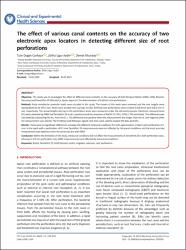The effect of various canal contents on the accuracy of two electronic apex locators in detecting different size of root perforations
Abstract
Objective: This study was to investigate the effect of different canal contents on the accuracy of Gold Reciproc Motor (GRM; VDW, Munich, Germany) and DentaPort ZX (Morita Co, Kyoto, Japan) in the determination of artificial root perforations.
Methods: Forty mandibular premolar teeth were included in this study. The crowns of the teeth were removed and the root lengths were standardized to be 14 +/- 1 mm. Roots were divided into 2 groups (n=20). Artificial root perforations were created 0.5 +/- 0.1mm and 1 +/- 0.1 mm in size respectively. The actual lengths (AL) up to the perforation areas were measured under the stereomicroscope. Electronic measurements (EL) were obtained by GRM and DentaPort ZX in dry conditions and the presence of NaOCl (5.25%), EDTA (17%) and blood. The difference was calculated by subtracting the ALs from the ELs. This difference was positive when the measurement was longer than the AL and negative when the measurement was shorter. The Friedman and Wilcoxon signed-rank tests were used to analyze the data (p<0.05).
Results: There were no significant differences amongst the different intracanal conditions for both apex locators in teeth with perforation of 1 mm. In the teeth with a perforation of 0.5 mm DentaPort ZX measurements were not affected by intracanal conditions and the most accurate measurement was obtained when the canal was dry with GRM.
Conclusion: Within the limitation of this study, intracanal conditions did not affect the measurements of DentaPort ZX in both perforation sizes, whereas in 0.5 mm perforation size, GRM measurements were affected by intracanal conditions..
Source
Clinical and Experimental Health SciencesVolume
11Issue
2URI
https://hdl.handle.net/20.500.12868/1640https://dergipark.org.tr/en/pub/clinexphealthsci/issue/62013/739588


















